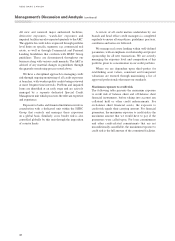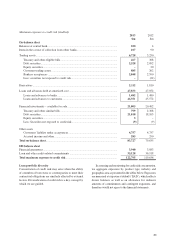HSBC 2013 Annual Report Download - page 44
Download and view the complete annual report
Please find page 44 of the 2013 HSBC annual report below. You can navigate through the pages in the report by either clicking on the pages listed below, or by using the keyword search tool below to find specific information within the annual report.
42
Our liquidity and funding management processes
include:
– projecting cash flows under various stress scenarios
and considering the level of liquid assets necessary in
relation thereto;
– monitoring the statement of financial position
liquidity ratios against internal measures;
– maintaining a diverse range of funding sources;
– managing the concentration and profile of debt
maturities;
– managing contingent liquidity commitment
exposures within predetermined caps;
– maintaining debt financing plans;
– monitoring depositor concentration in order to avoid
undue reliance on large individual depositors and
ensuring a satisfactory overall funding mix; and
– maintaining liquidity and funding contingency plans.
Liquidity regulation
In 2010, the Basel Committee on Banking Supervision
(‘BCBS’) published a framework document prescribing
two liquidity standards: the liquidity coverage ratio
(‘LCR’) and the net stable funding ratio (‘NSFR’),
together referred to as the Basel liquidity standards. The
LCR estimates the adequacy of liquidity over a 30 day
stress period. The NSFR estimates the extent to which
assets are funded by longer-term stable liabilities.
In January 2013, the BCBS released its final rules for
LCR. In January 2014, the BCBS issued a consultation
document on a revised framework for the NSFR.
In November 2013, OSFI issued a draft guideline
Liquidity Adequacy Requirements. The guideline,
expected to be finalized in 2014, incorporates the Basel
liquidity standards, introduces a suite of additional
liquidity monitoring tools, and formalizes OSFI’s use of
the Net Cumulative Cash Flow (‘NCCF’) supervisory
tool. According to the draft guideline, LCR and NCCF
will be in force as of 1 January 2015. NSFR is expected
to follow the BCBS implementation timelines in 2018.
Advances to core funding ratio
The bank emphasizes the importance of core current
accounts and savings accounts as a source of funds to
finance lending to customers, and discourages reliance
on short-term professional funding. This is achieved by
placing limits to restrict the bank’s ability to increase
loans and advances to customers without corresponding
growth in current accounts and savings accounts or
long-term debt funding with a residual maturity beyond
one year. This measure is referred to as the ‘advances to
core funding’ ratio.
The ratio describes loans and advances to customers
as a percentage of the total of core customer current and
savings accounts and term funding with a remaining term
to maturity in excess of one year. Loans and advances
to customers which are part of reverse repurchase
arrangements, and where the bank receives securities
which are deemed to be liquid, are excluded from the
advances to core funding ratio, as are current accounts
and savings accounts from customers deemed to be
‘non-core’. The categorization of customer deposits into
core and non-core takes into account the nature of the
customer and the size and pricing of the deposit.
The distinction between core and non-core deposits
generally means that the bank’s measure of advances to
core funding is more restrictive than that which could be
inferred from the published financial statements.
Advances to core funding ratio (Unaudited)
2013
%
2012
%
Year-end ......................................................................................................................... 93 96
Maximum ....................................................................................................................... 100 96
Minimum........................................................................................................................ 93 90
Average .......................................................................................................................... 96 94
Stress testing
The bank runs a range of stressed cash flow scenarios
as its primary liquidity risk measures, spanning various
idiosyncratic and market-wide stress scenarios. Stressed
cash flow scenarios are further supplemented by regular
enterprise-wide stress testing and reverse stress testing.
The results of all liquidity stress tests are reviewed and
monitored by ALCO.
We would meet any unexpected cash outflows
primarily from our cash, by selling or entering into
repurchase agreements (‘repos’) with the securities
assessed as liquid assets, and by maturing interbank
loans and reverse repos. In general, customer advances
are assumed to be renewed and as a result are not
assumed to generate a stressed cash inflow or represent
a liquidity resource.
Management’s Discussion and Analysis (continued)
HSBC BANK CANADA
42
























